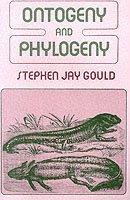
- Format
- Häftad (Paperback / softback)
- Språk
- Engelska
- Antal sidor
- 520
- Utgivningsdatum
- 1985-01-01
- Upplaga
- New ed
- Förlag
- The Belknap Press
- Illustratör/Fotograf
- illustrations
- Illustrationer
- 71 line illustrations
- Dimensioner
- 235 x 153 x 30 mm
- Vikt
- Antal komponenter
- 1
- Komponenter
- WORKSHEET
- ISBN
- 9780674639416
- 700 g
Ontogeny and Phylogeny
- Skickas från oss inom 3-6 vardagar.
- Fri frakt över 249 kr för privatkunder i Sverige.
Passar bra ihop
De som köpt den här boken har ofta också köpt The Anxious Generation av Jonathan Haidt (inbunden).
Köp båda 2 för 1148 krKundrecensioner
Fler böcker av Stephen Jay Gould
-
The Mismeasure of Man
Stephen Jay Gould
-
The Panda's Thumb
Stephen Jay Gould
-
Wonderful Life
Stephen Jay Gould
-
The Richness of Life
Stephen Jay Gould, Paul McGarr, Steven Rose
Recensioner i media
In Gouldsnew bookOntogeny and Phylogeny, a scholarly study of the theory of recapitulation, he not only explains scientific theory but comments on science itself, with clarity and wit, simultaneously entertaining and teaching [This] is a rich book. -- James Gorman * New York Times Book Review * Steven Jay Gould has given us a superb analysis of the use of ontogenetic analogy, the controversies over ontogeny and phylogeny, and the classification of the different processes observable in comparing different ontogenies. His massive book (in each chapter of which there is as much material as in whole books by other writers) is both a historical exposition of the whole subject of ontogeny and phylogeny, anda fascinating attempt at a functional interpretation of those phylogenetic alterations that involve changes of timing developmental processes in related organisms. -- A. J. Cain * Nature * This [is a] fat, handsome book crammed with provocative ideas Ontogeny and Phylogeny is an important and thoughtful book which will be a valuable source of ideas and controversies for anyone interested in evolutionary or developmental biology. -- Matt Cartmill * Science * It is rare indeed to read a new book and recognize it for a classic Gould has given biologists a new way to see the organisms they study. The result is a major achievement. -- S. Rachootin * American Scientist * Goulds bookpervaded, I should say, with an erudition and felicity of style that make it a delight to readis a radical work in every sense It returns ones attention to the roots of our sciencethe questions about the great pageant of evolution, the marvelous diversity of form that our theory is meant to explain. -- D. Futuyma * Quarterly Review of Biology * A distinguished and pioneering work. -- Ernst Mayr
Övrig information
Stephen Jay Gould was Alexander Agassiz Professor of Zoology at Harvard University and Vincent Astor Visiting Professor of Biology at New York University. A MacArthur Prize Fellow, he received innumerable honors and awards and wrote many books, including Ontogeny and Phylogeny and Times Arrow, Times Cycle (both from Harvard).
Innehållsförteckning
* *1. Prospectus * Part I: Recapitulation *2. The Analogistic Tradition from Anaximander to Bonnet * The Seeds of Recapitulation in Greek Science? * Ontogeny and Phylogeny in the Conflict of "Evolution" and Epigenesis: The Idyll of Charles Bonnet * Appendix: The Revolution in "Evolution" *3. Transcendental Origins, 1793--1860 * Naturphilosophie: An Expression of Developmentalism * Two Leading Recapitulationists among the Naturphilosophen: Oken and Meckel * Oken's Classification of Animals Linear Additions of Organs * J. F. Meckel's Sober Statement of the Same Principles * Serres and the French Transcendentalists * Recapitulation and the Theory of Developmental Arrests * Von Baer's Critique of Recapitulation * The Direction of Development and Classification of Animals * Von Baer and Naturphilosophie: What Is the Universal Direction of Development? * Louis Agassiz and the Threefold Parallelism *4. Evolutionary Triumph, 1859--1900 * Evolutionary Theory and Zoological Practice * Darwin and the Evolution of Von Baer' Laws * Evolution and the Mechanics of Recapitulation * Ernst Haeckel: Phylogeny as the Mechanical Cause of Ontogeny * The Mechanism of Recapitulation * The American Neo-Lamarckians: The Law of Acceleration as Evolution's Motor * Progressive Evolution by Acceleration * The Extent of Parallelism * Why Does Recapitulation Dominate the History of Life? * Alpheus Hyatt and Universal Acceleration * Lamarckism and the Memory Analogy * Recapitulation and Darwinism * Appendix: The Evolutionary Translation of von Baer's Laws *5. Pervasive Influence * Criminal Anthropology * Racism * Child Development * Primary Education * Freudian Psychoanalysis * Epilogue *6. Decline, Fall, and Generalization * A Clever Argument * An Empirical Critique * Organs or Ancestors: The Transformation of Haeckel's Heterochrony * Interpolations into Juvenile Stages * Introduction of Juvenile Features into the Adults of Descendants * What Had Become of von Baer's Critique? * Benign Neglect: Recapitulation and the Rise of Experimental Embryology * The Prior Assumptions of Recapitulation * Wilhelm His and His Physiological Embryology: A Preliminary Skirmish * Roux's Entwicklungsmechanik and the Biogenetic Low * Recapitulation and Substantive Issues in Experimental Embryology: The New Preformationism * Mendel's Resurrection, Haeckel's Fall, and the Generalization of Recapitulation * Part II: Heterocrony and Paedomorphosis *7. Heterochrony and the Parallel of Ontogeny and Phylogeny * Acceleration and Retardation * Confusion in and after Haeckel's Wake * Guidelines for a Resolution * The Reduction of de Beer's Categories of Heterochrony to Acceleration and Retardation * A Historical Paradox: The Supposed Dominance of Recapitulation * Dissociability and Heterochrony * Correlation and Disociability * Dissociation of the Three Processes * A Metric for Dissociation * Temporal Shift as a Mechanism of Dissociation * A Clock Model of Heterochrony * Appendix: A Note on the Multivariate Representation of Dissociation *8. The Ecological and Evolutionary Significance of Heterochrony * The Argument from Frequency * The Importance of Recapitulation * The Importance of Heterochronic Change: Selected Cases * Frequency of Paedomorphosis in the Origin of Higher Taxa * A Critique of the Classical Significance of Heterochrony * The Classical


